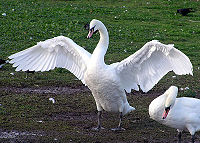Swan
 From Conservapedia
From Conservapedia | Swan | |
|---|---|

| |
| Mute swan Cygnus olor | |
| Scientific classification | |
| Kingdom Information | |
| Domain | Eukaryota |
| Kingdom | Animalia |
| Subkingdom | Bilateria |
| Branch | Deuterostomia |
| Phylum Information | |
| Phylum | Chordata |
| Sub-phylum | Vertebrata |
| Infraphylum | Gnathostomata |
| Class Information | |
| Superclass | Tetrapoda |
| Class | Aves |
| Sub-class | Avialae |
| Order Information | |
| Superorder | Galloanserimorphae |
| Order | Anseriformes |
| Sub-order | Anseres |
| Infraorder | Anserides |
| Family Information | |
| Superfamily | Anatoidea |
| Family | Anatidae |
| Sub-family | Anserinae |
| Tribe Information | |
| Tribe | Cygnini |
| Genus Information | |
| Genus | Cygnus |
| Population statistics | |
Swans are several species of large waterfowl of the order Anseriformes.
The plumage of swans is either white, black (especially among Antipodean varieties), or a combination of the two (e.g. the black-necked swan).
In Britain the Crown owns all unmarked mute swans in open water, but currently the Queen only exercises her ownership rights on some stretches of the River Thames and its tributaries. Other varieties of swan (Bewick's, Whooper) are not included in this. The Swan Upping ceremony which takes place every July takes a head-count of all the mute swans on the Thames and marks them for ownership either by the Crown or by the Vintners' and Dyers' Livery Companies, which were granted their rights of ownership by the Crown in the fifteenth century.[1]
Swans are aggressively territorial in defense of their nests.
Contents
Swans and fidelity[edit]
Swans often form pairs for life, and if the mate of a swan dies the surviving partner never "remarries." They anthropomorphize this behavior, stating swans are therefore a very good lesson to us, as they uphold monogamous values.[2][3][4][5] This behavior is not universal among swans, with researchers finding multiple instances of swan infidelity, DNA testing shows one in six cygnets is a result of an "extra-marital" encounter.[6]
Species[edit]
- Black swan, Cygnus atratus
- Black-necked swan, Cygnus melancoryphus
- Mute swan, Cygnus olor
- Trumpeter swan, Cygnus buccinator
- Tundra swan, Cygnus columbianus
- Whooper swan, Cygnus cygnus
The Coscoroba swan (Coscoroba coscoroba) had at one time been considered a true swan; recent studies have indicated that it belongs in the same group as geese and shelducks, with the Cape Barren goose (Cereopsis novaehollandiae) as its closest relative.
Swan in music and literature[edit]
Ballet Swan Lake, this most revered of classical ballets, the music was wroten by Pyotr Ilyich Tchaikovsky in 1875.
The legend of the Swan-Maiden goes back for centuries, appearing in differing forms in both eastern and western literature. Women who turn into birds and vice versa were popular themes, and the swan was particularly favored due to its grace when swimming in the water. The ancient Greeks considered the swan to the bird closest to the Muses. When Apollo was born at Delos, the event was celebrated by flights of circling swans. [7]
See also[edit]
External links[edit]
- Swan - Photos
- Swan The Royal Botanic Gardens.
References[edit]
- ↑ Swan Upping: Annual "Swan Marking" on the Thames by the Vintners' Company, The Dyers' Company and The Monarch's Swan Marker
- ↑ Coleman, A 39 year study of a mute swan population
- ↑ http://www.avibirds.com/pdf/K/Knobbelzwaan1.pdf
- ↑ Crane, Louise (December 4, 2014). The truth about swans. BBC. Retrieved February 13, 2018.
- ↑ 10 Amorous Animals That Mate for Life. National Geographic. Retrieved February 13, 2018.
- ↑ [1]
- ↑ The Origins of Swan Lake
Categories: [Birds] [Meat] [Hunting]
↧ Download as ZWI file | Last modified: 02/27/2023 01:09:05 | 12 views
☰ Source: https://www.conservapedia.com/Swan | License: CC BY-SA 3.0
 ZWI signed:
ZWI signed: KSF
KSF